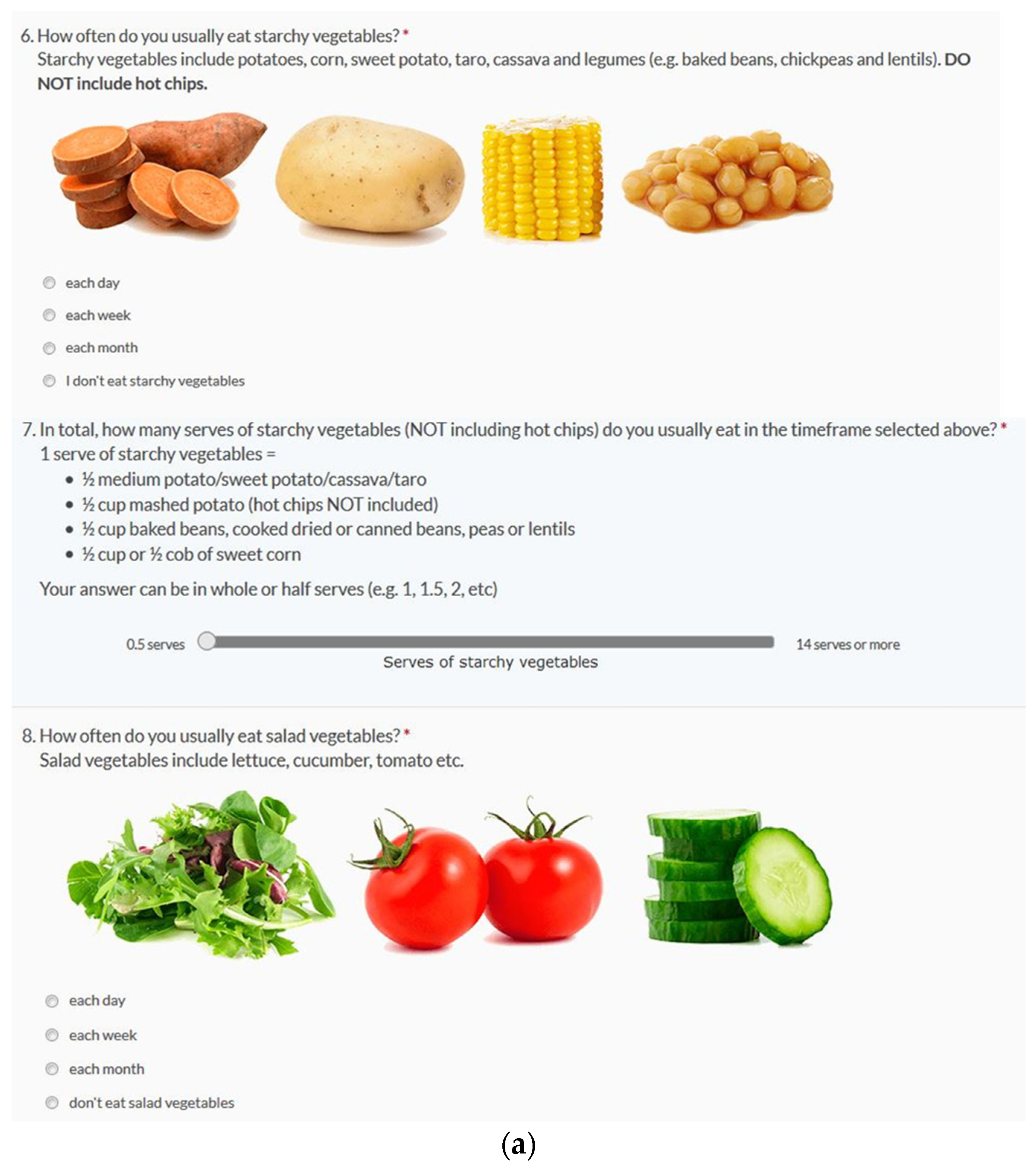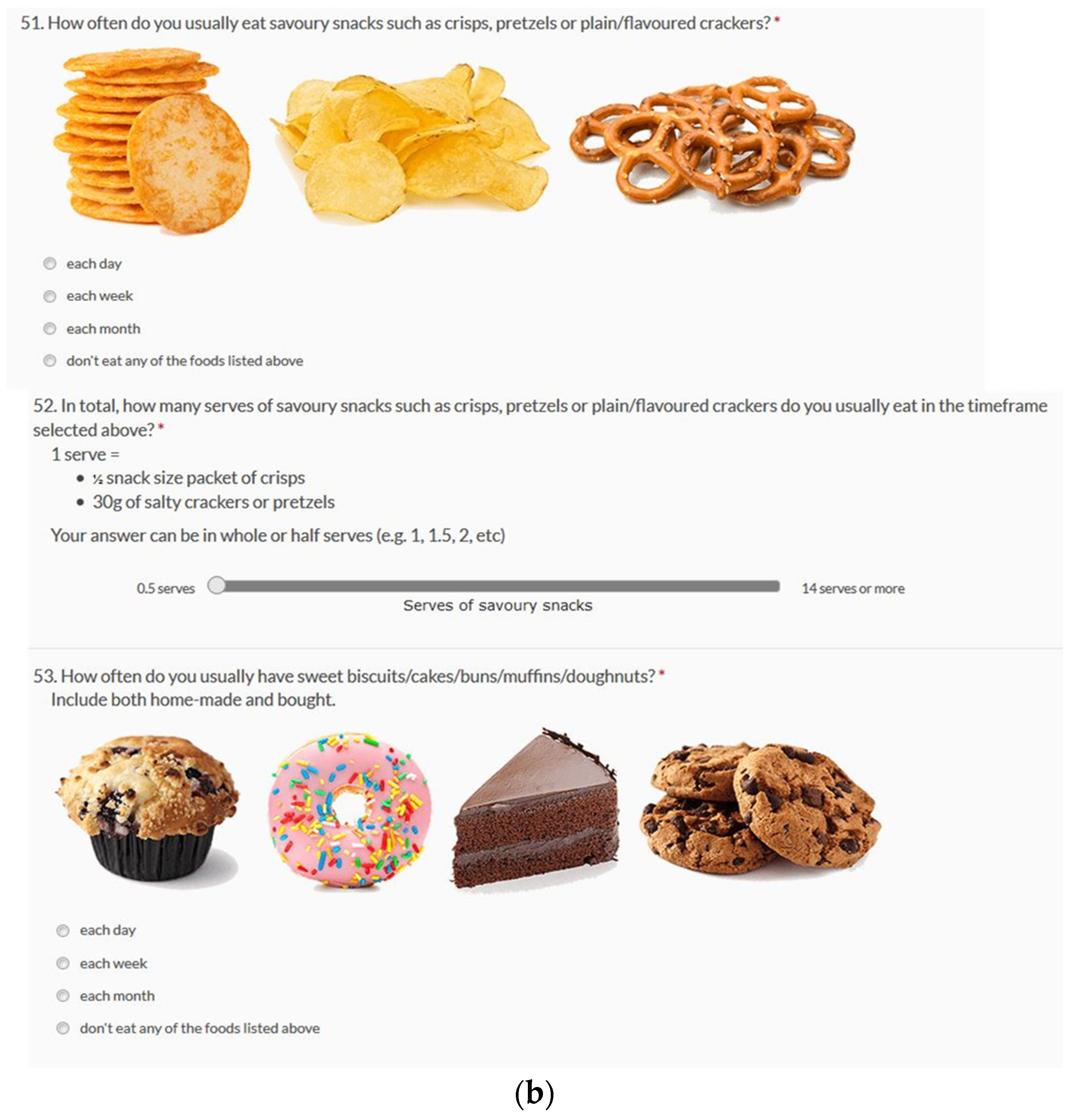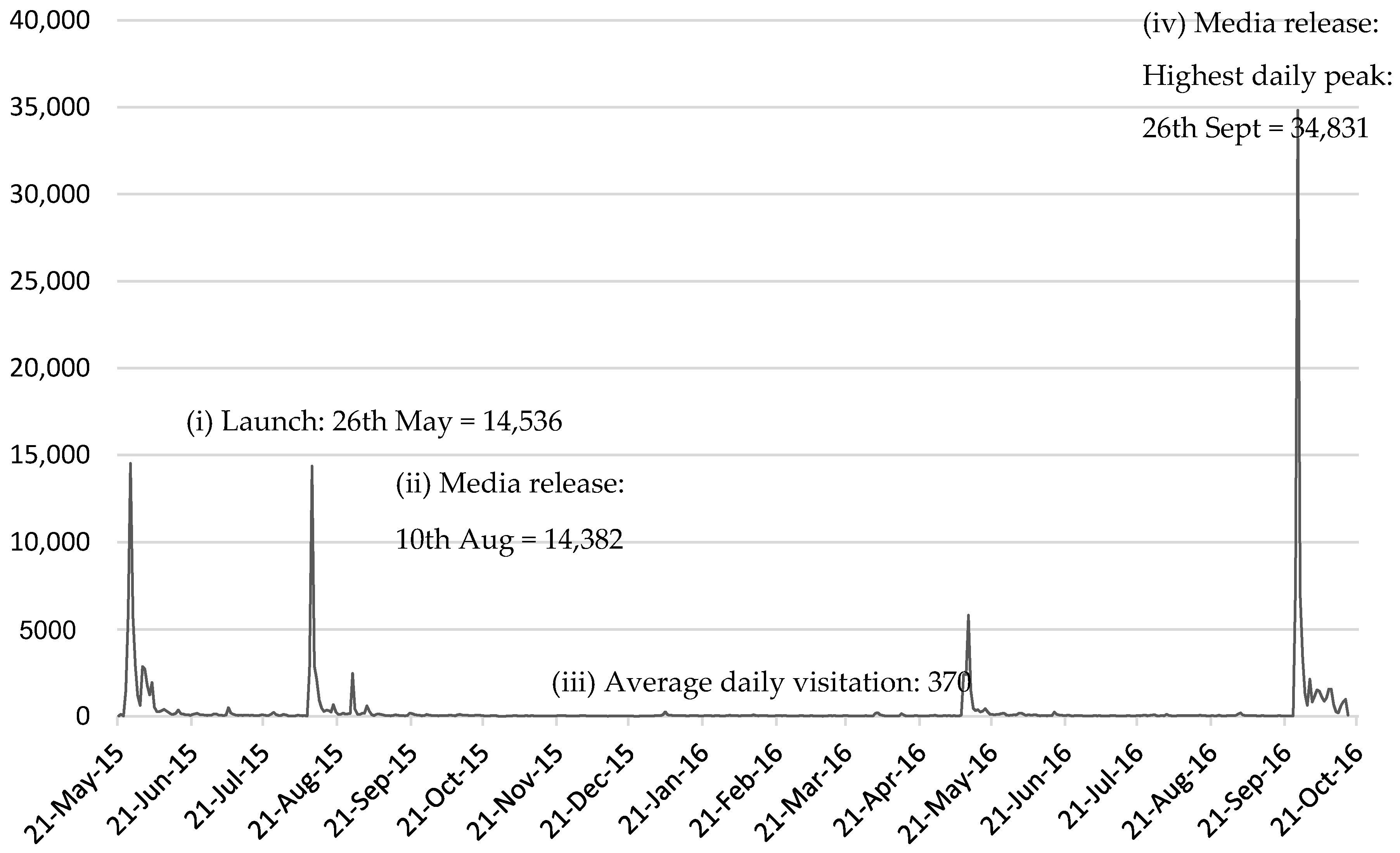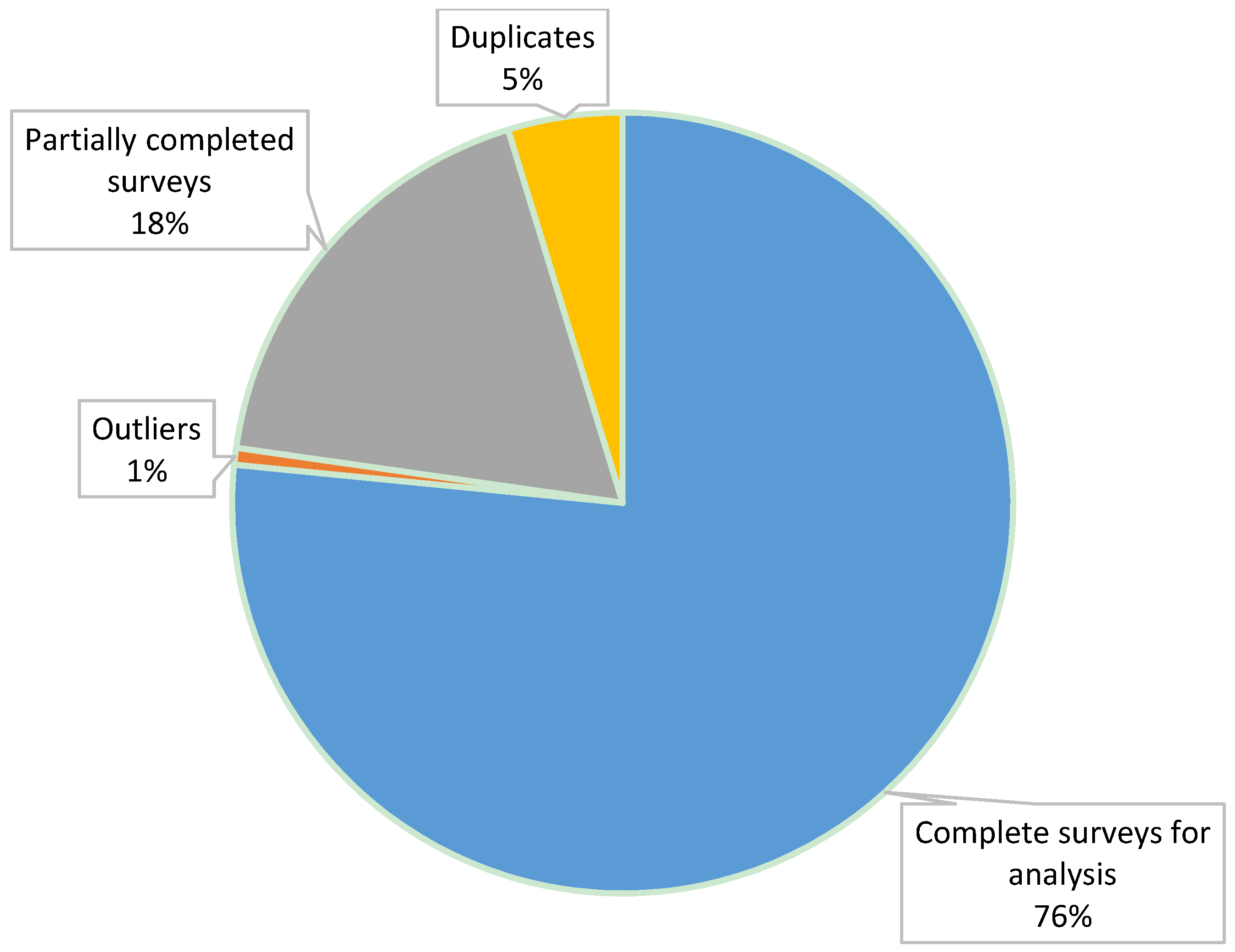The CSIRO Healthy Diet Score: An Online Survey to Estimate Compliance with the Australian Dietary Guidelines
Abstract
:1. Introduction
2. Materials and Methods
3. Results
3.1. Sample Characteristics
3.2. Variation in the Diet Score within the Sample
3.3. How do Australian Diets Compare to the Australian Dietary Guidelines?
3.4. User Feedback
4. Discussion
5. Conclusions
Acknowledgments
Author Contributions
Conflicts of Interest
References
- Khanna, N.; Boushey, C.J.; Kerr, D.; Okos, M.; Ebert, D.S.; Delp, E.J. An overview of the Technology Assisted Dietary Assessment project at Purdue University. ISM 2010, 290–295. Available online: https://www.ncbi.nlm.nih.gov/pubmed/22020443 (accessed on 14 November 2016). [Google Scholar]
- Hedrick, V.E.; Dietrich, A.M.; Estabrooks, P.A.; Savla, J.; Serrano, E.; Davy, B.M. Dietary biomarkers: Advances, limitations and future directions. Nutr. J. 2012, 11, 109. [Google Scholar] [CrossRef] [PubMed]
- Subar, A.F.; Kirkpatrick, S.I.; Mittl, B.; Zimmerman, T.P.; Thompson, F.E.; Bingley, C.; Willis, G.; Islam, N.G.; Baranowski, T.; McNutt, S.; et al. The automated self-administered 24-hour dietary recall (ASA24): A resource for researchers, clinicans and educators from the National Cancer Institute. J. Acad. Nutr. Diet. 2012, 112, 1134–1137. [Google Scholar] [CrossRef] [PubMed]
- Tooze, J.A.; Midthune, D.; Dodd, K.W.; Freedman, L.S.; Krebs-Smith, S.M.; Subar, A.F.; Guenther, P.M.; Carroll, R.J.; Kipnis, V. A new method for estimating the usual intake of episodically-consumed foods with application to their distribution. J. Am. Diet. Assoc. 2006, 106, 1575–1587. [Google Scholar] [CrossRef] [PubMed]
- Cade, J.E.; Burley, V.J.; Warm, D.L.; Thompson, R.L.; Margetts, B.M. Food-frequency questionnaires: A review of their design, validation and utilisation. Nutr. Res. Rev. 2004, 17, 5–22. [Google Scholar] [CrossRef] [PubMed]
- Burrows, T.L.; Martin, R.J.; Collins, C.E. A systematic review of the validity of dietary assessment methods in children when compared with the method of doubly labeled water. J. Am. Diet. Assoc. 2010, 110, 1501–1510. [Google Scholar] [CrossRef] [PubMed]
- Golley, R.K.; Bell, L.K.; Hendrie, G.A.; Rangan, A.M.; Spence, A.; McNaughton, S.A.; Carpenter, L.; Allman-Farinelli, M.; de Silva, A.; Gill, T.; et al. Validity of short food questionnaire items to measure intake in children and adolescents: A systematic review. J. Hum. Nutr. Diet. 2016. [Google Scholar] [CrossRef] [PubMed]
- Golley, R.K.; Hendrie, G.A. The Dietary Guidelines Index for Children and Adolescents: What is the impact of the new dietary guidelines? Nutr. Diet. 2014. [Google Scholar] [CrossRef]
- Hendrie, G.A.; Rebuli, M.A.; Golley, R.K. Reliability and relative validity of a diet index score for adults derived from a self-reported short food survey. Nutr. Diet. 2016. [Google Scholar] [CrossRef]
- Hendrie, G.A.; Viner-Smith, B.; Golley, R.K. The reliability and relative validity of a diet index score for 4–11 years old children derived from a parent reported short food survey. Public Health Nutr. 2013, 17, 1486–1497. [Google Scholar] [CrossRef] [PubMed]
- Australian Bureau of Statistics. 4363.0.55.001 Australian Health Survey: Users’ Guide, 2011–13. Available online: http://www.abs.gov.au/ausstats/[email protected]/mf/4363.0.55.001 (accessed on 14 November 2016).
- Australian Bureau of Statistics; Department of Health and Family Services. National Nutrition Survey Selected Highlights Australia 1995; Cat No. 4802.0; Australian Bureau of Statistics: Canberra, Australia, 1997.
- Golley, R.K.; Hendrie, G.A.; McNaughton, S.A. Scores on the Dietary Guideline Index for Children and Adolescents are associated with nutrient intake and socio-economic position but not adiposity. J. Nutr. 2011, 141, 1340–1347. [Google Scholar] [CrossRef] [PubMed]
- National Health & Medical Research Council; Department of Health and Ageing. Eat for Health. Australian Dietary Guidelines: Educators Guide; Commonwealth of Australia: Canberra, Australia, 2013. [Google Scholar]
- Australian Bureau of Statistics. 4364.0.55.001 Australian Health Survey: Nutrition First Results—Food and Nutrients, 2014–2015. Available online: http://www.abs.gov.au/ausstats/[email protected]/Lookup/4364.0.55.007main+features12011-12 (accessed on 14 November 2016).
- Livingstone, K.M.; McNaughton, S.A. Diet quality is associated with obesity and hypertension in Australian adults: A cross sectional study. BMC Public Health 2016, 16, 1037. [Google Scholar] [CrossRef] [PubMed]
- Boeing, H.; Bechthold, A.; Bub, A.; Ellinger, S.; Haller, D.; Kroke, A.; Leschik-Bonnet, E.; Müller, M.J.; Oberritter, H.; Schulze, M.; et al. Critical review: Vegetables and fruit in the prevention of chronic diseases. Eur. J. Nutr. 2012, 51, 637–663. [Google Scholar] [CrossRef] [PubMed]
- World Health Organisation; Food and Agriculture Organization of the United Nations. Diet, Nutrition and the Prevention of Chronic Diseases; World Health Organization: Geneva, Switzerland, 2003. [Google Scholar]
- Department of Health and Ageing Go for 2 & 5 Campaign. Available online: http://www.gofor2and5.com.au/ (accessed on 14 November 2016).
- National Health Service ‘5 A day’ Live Well. Available online: http://www.nhs.uk/livewell/5aday/pages/5adayhome.aspx (accessed on 14 November 2016).
- U.S. Department of Health and Human Services. Available online: http://www.fruitsandveggiesmorematters.org/ (accessed on 14 November 2016).
- Australian Bureau of Statistics. 4364.0.55.012 Australian Health Survey: Consumption of Food Groups from the Australian Dietary Guidelines, 2011–12. Available online: http://www.abs.gov.au/ausstats/[email protected]/Lookup/4364.0.55.012main+features12011-12 (accessed on 14 November 2016).
- Grieger, J.A.; Wycherley, T.P.; Johnson, B.J.; Golley, R.K. Discrete strategies to reduce intake of discretionary food choices: A scoping review. Int. J. Behav. Nutr. Phys. Act. 2016, 13. [Google Scholar] [CrossRef] [PubMed]
- Archer, E.; Hand, G.A.; Blair, S.N. Validity of U.S. Nutritional Surveillance: National Health and Nutrition Examination Survey Caloric Energy Intake Data, 1971–2010. PLoS ONE 2013, 8, e76632. [Google Scholar] [CrossRef]
- Briefel, R.R.; Sempos, C.T.; McDowell, M.A.; Chien, S.; Alaimo, K. Dietary methods research in the third National Health and Nutrition Examination Survey: Underreporting of energy intake. Am. J. Clin. Nutr. 1997, 65, 1203S–1209S. [Google Scholar] [PubMed]
- Johansson, G.; Wikman, A.; Ahren, A.; Hallmans, G.; Johansson, I. Underreporting of energy intake in repeated 24-hour recalls related to gender, age, weight status, day of interview, educational level, reported food intake, smoking habits and area of living. Public Health Nutr. 2001, 4, 919–927. [Google Scholar] [CrossRef] [PubMed]
- Macdiarmid, J.; Blundell, J. Assessing dietary intake: Who, what and why of under-reporting. Nutr. Res. Rev. 1998, 11, 231–253. [Google Scholar] [CrossRef] [PubMed]
- Herbert, J.R.; Clemow, L.; Pbert, L.; Ockene, I.S.; Ockene, J.K. Social Desirability Bias in Dietary Self-Report May Compromise the Validity of Dietary Intake Measures. Int. J. Epidemiol. 1995, 24, 389–398. [Google Scholar] [CrossRef]
- Ding, D.; Do, A.; Schmidt, H.M.; Bauman, A.E. A Widening Gap? Changes in Multiple Lifestyle Risk Behaviours by Socioeconomic Status in New South Wales, Australia, 2002–2012. PLoS ONE 2015, 10, e0135338. [Google Scholar] [CrossRef] [PubMed]
- Ball, K.; Lamb, K.E.; Costa, C.; Cutumisu, N.; Ellaway, A.; Kamphuis, C.B.; Mentz, G.; Pearce, J.; Santana, P.; Santos, R.; et al. Neighbourhood socioeconomic disadvantage and fruit and vegetable consumption: A seven countries comparison. Int. J. Behav. Nutr. Phys. Act. 2015, 12, 68. [Google Scholar] [CrossRef] [PubMed]
- Ali, M.K.; Bhaskarapillai, B.; Shivashankar, R.; Mohan, D.; Fatmi, Z.A.; Pradeepa, R.; Masood Kadir, M.; Mohan, V.; Tandon, N.; Narayan, K.M.; et al. Socioeconomic status and cardiovascular risk in urban South Asia: The CARRS Study. Eur. J. Prev. Cardiol. 2016, 23, 408–419. [Google Scholar] [CrossRef] [PubMed]
- Australian Bureau of Statistics 2011 Census QuickStats. Available online: http://www.abs.gov.au/websitedbs/censushome.nsf/home/quickstats (accessed on 14 November 2016).
- McNaughton, S.A.; Ball, K.; Crawford, D.; Mishra, G.D. An index of diet and eating patterns is a valid measure of diet quality in an Australian population. J. Nutr. 2008, 138, 86–93. [Google Scholar] [PubMed]
- Daly, A.M.; Pollard, C.M.; Kerr, D.A.; Binns, C.W.; Phillips, M. Using short dietary questions to develop indicators of dietary behaviour for use in surveys exploring attitudinal and/or behavioural aspects of dietary choices. Nutrients 2015, 7, 6330–6345. [Google Scholar] [CrossRef] [PubMed]
- Hebden, L.; Kostan, E.; O’Leary, F.; Hodge, A.; Allman-Farinelli, M. Validity and reproducibility of a food frequency questionnaire as a measure of recent dietary intake in young adults. PLoS ONE 2013, 8, e75156. [Google Scholar] [CrossRef] [PubMed]
- Cancer Council Victoria Dietary Questionnaire for Epidemiological Studies. Available online: http://www.cancervic.org.au/research/epidemiology/nutritional_assessment_services (accessed on 14 November 2016).
- The University of Newcastle Australian Eating Survey. Available online: http://newcastleinnovation.com.au/AES/ (accessed on 14 November 2016).
- Collins, C.E.; Burrows, T.L.; Rollo, M.E.; Boggess, M.M.; Watson, J.F.; Guest, M.; Duncanson, K.; Pezdirc, K.; Hutchesson, M.J. The comparative validity and reproducibility of a diet quality index for adults: The Australian Recommended Food Score. Nutrients 2015, 7, 785–798. [Google Scholar] [CrossRef] [PubMed]




| Sample Characteristics | Diet Score | ||||
|---|---|---|---|---|---|
| Count (n) | % of Total | Mean | SD | ||
| Gender | Male | 42,385 | 29.0% | 56.2 | 13.1 |
| Female | 103,590 | 71.0% | 59.9 | 12.6 | |
| Age group | 18–30 years | 44,534 | 30.5% | 57.3 | 13.2 |
| 31–50 years | 52,599 | 36.0% | 57.3 | 12.6 | |
| 51–70 years | 44,096 | 30.2% | 61.8 | 12.2 | |
| 71+ years | 4746 | 3.3% | 63.1 | 11.7 | |
| Weight status | Underweight | 3685 | 2.5% | 59.6 | 14.4 |
| Normal weight | 70,205 | 48.2% | 60.5 | 12.6 | |
| Overweight | 44,376 | 30.4% | 58.1 | 12.5 | |
| Obese | 27,517 | 18.9% | 55.7 | 13.2 | |
| State of residence | New South Wales | 39,313 | 27.2% | 59.2 | 12.8 |
| Queensland | 20,988 | 14.5% | 58.2 | 13.1 | |
| Australian Capital Territory | 6047 | 4.2% | 59.7 | 12.4 | |
| Northern Territory | 1197 | 0.8% | 58.3 | 12.7 | |
| Tasmania | 4418 | 3.1% | 57.6 | 13.1 | |
| Victoria | 44,558 | 30.8% | 59.0 | 12.8 | |
| Western Australia | 13,415 | 9.3% | 58.2 | 12.6 | |
| South Australia | 14,631 | 10.1% | 58.7 | 12.9 | |
| Occupation | Retired | 15,238 | 10.6% | 62.8 | 12.0 |
| Administration | 13,645 | 9.5% | 57.8 | 12.7 | |
| Student | 16,152 | 11.2% | 58.4 | 13.2 | |
| Health industry | 13,799 | 9.6% | 61.9 | 12.3 | |
| Education/Research | 17,896 | 12.4% | 59.9 | 12.1 | |
| Science/Programming | 8728 | 6.1% | 57.2 | 12.6 | |
| Homemaker | 6398 | 4.4% | 59.1 | 13.0 | |
| Management/Finance | 18,394 | 12.8% | 58.0 | 12.3 | |
| Sales/Marketing/PR | 7723 | 5.4% | 56.4 | 12.8 | |
| Customer and Food Service | 6028 | 4.2% | 55.4 | 13.8 | |
| Media/Arts | 3187 | 2.2% | 58.2 | 12.3 | |
| Construction Industry | 2860 | 2.0% | 54.2 | 13.4 | |
| Unemployed | 2118 | 1.5% | 54.1 | 15.0 | |
| Other | 11,807 | 8.2% | 58.0 | 13.1 | |
| Component Scores (out of 100) * | Male | Female | Total | |||
|---|---|---|---|---|---|---|
| Mean | SD | Mean | SD | Mean | SD | |
| Diet Score | 56.2 | 13.1 | 59.9 | 12.6 | 58.8 | 12.9 |
| Food Group Component Scores | ||||||
| Fluids | 88.7 | 18.4 | 93.6 | 14.0 | 92.2 | 15.5 |
| Vegetables | 61.6 | 29.6 | 74.0 | 27.8 | 70.4 | 28.9 |
| Meat and alternatives | 68.3 | 26.1 | 70.9 | 25.3 | 70.2 | 25.6 |
| Fruit | 65.9 | 36.8 | 68.7 | 35.2 | 67.9 | 35.7 |
| Variety | 64.4 | 13.3 | 65.0 | 13.0 | 64.9 | 13.1 |
| Breads and cereals | 62.2 | 24.6 | 60.9 | 24.4 | 61.3 | 24.4 |
| Healthy fats | 50.9 | 28.7 | 54.1 | 26.7 | 53.1 | 27.3 |
| Dairy and substitutes | 47.8 | 25.5 | 48.0 | 26.5 | 47.9 | 26.2 |
| Discretionary foods | 25.8 | 31.0 | 32.0 | 32.3 | 30.2 | 32.1 |
| Food Group Component | Male | Female | Total |
|---|---|---|---|
| % | % | % | |
| Discretionary foods | 76.8 | 72.5 | 73.8 |
| Dairy and substitutes | 51.3 | 57.2 | 55.5 |
| Healthy fats | 45.3 | 47.7 | 47.0 |
| Fruit | 33.1 | 32.5 | 32.7 |
| Breads and cereals | 23.0 | 29.6 | 27.7 |
| Vegetables | 32.8 | 20.6 | 24.2 |
| Meat and alternatives | 22.4 | 22.6 | 22.7 |
| Variety | 11.4 | 15.0 | 14.0 |
| Fluids | 3.9 | 1.9 | 2.5 |
© 2017 by the authors; licensee MDPI, Basel, Switzerland. This article is an open access article distributed under the terms and conditions of the Creative Commons Attribution (CC-BY) license (http://creativecommons.org/licenses/by/4.0/).
Share and Cite
Hendrie, G.A.; Baird, D.; Golley, R.K.; Noakes, M. The CSIRO Healthy Diet Score: An Online Survey to Estimate Compliance with the Australian Dietary Guidelines. Nutrients 2017, 9, 47. https://doi.org/10.3390/nu9010047
Hendrie GA, Baird D, Golley RK, Noakes M. The CSIRO Healthy Diet Score: An Online Survey to Estimate Compliance with the Australian Dietary Guidelines. Nutrients. 2017; 9(1):47. https://doi.org/10.3390/nu9010047
Chicago/Turabian StyleHendrie, Gilly A., Danielle Baird, Rebecca K. Golley, and Manny Noakes. 2017. "The CSIRO Healthy Diet Score: An Online Survey to Estimate Compliance with the Australian Dietary Guidelines" Nutrients 9, no. 1: 47. https://doi.org/10.3390/nu9010047






